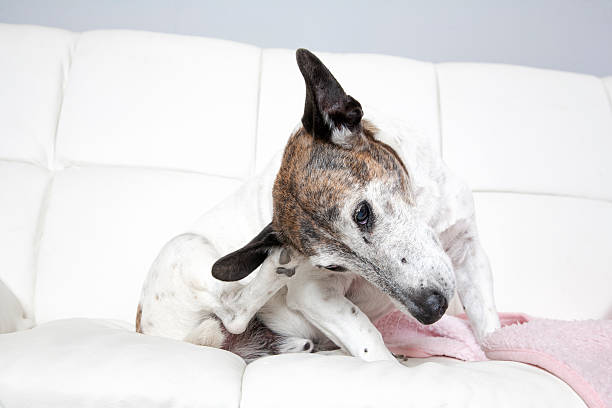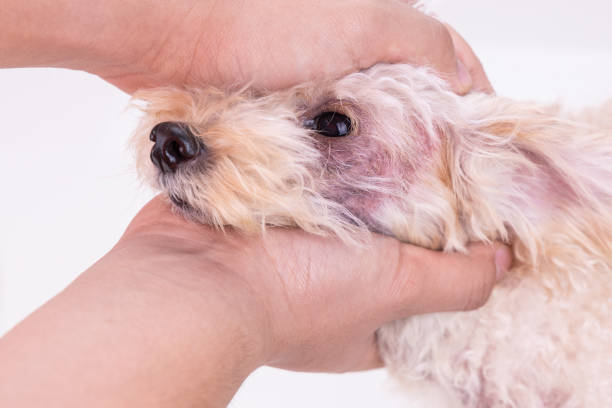Frequent occurrences of this can lead to a host of undesirable problems. Dog saliva harbors harmful bacteria and diseases that can proliferate on a multitude of surfaces, including carpets, furniture, clothing, etc. Surprisingly, a typical dog dispenses over 10 million bacteria per minute of drooling. This article elaborates on 10 likely challenges that could arise as a result of dog saliva.
1. Carpets
The most common problem you can expect from dog drooling is the damage it can cause to your carpets. As mentioned before, dog drool contains harmful bacteria and diseases that grow in carpets, causing stains, odours and disease. You might also find scratches on your carpet or linoleum floors left behind by your dog as it drags its mouth on the floor.
2. Furniture
Your couch and chairs will suffer a similar fate as your carpets if your dog drools on them too much. Your furniture can also harbour illnesses and bacteria, just like your carpets, which is why you should try to keep it clean from drool marks. Try covering your furniture with plastic or waterproof sheets to keep drool stains from getting on it.


3. Clothes
Your dog’s mouth contains all sorts of bacteria, including E. coli and Salmonella, which are just two of the many types of harmful bacteria that can be found in its mouth. If left unnoticed, your dog can transfer these harmful bacteria to your clothes, causing stains and promoting the growth of germs.
4. Floors
Constant drooling leads to stained floors, which can ruin the look of any room. Even if you’re not worried about their looks, you should definitely be concerned with how it will affect your feet as you walk across a sticky floor. To clean up your floors after drooling, you may have to use costly cleaners and harsh chemicals that can damage the surface of your flooring. You’ll also have to scrub the drool off the floor with a mop which will put your back out if it’s not done right.


5. Walls
Drool can also damage walls, causing discolouration and bad odours if left alone for too long. Prevent your dog’s drool from damaging your walls by hanging up pictures, paintings, or calendars around the area you deem at risk for drool marks. Also, put up shelves where it will be hard for the dog to reach with its mouth.
6. Illness
If left unchecked, the germs found in dog drool can cause illnesses and diseases-some of which can be transmitted to you or your family members. Many types of worms live in dog drool, so try to keep your pets away from any areas where you or your kids play.


7. Disease
Dogs can get all kinds of diseases and illnesses from drool, such as ringworm, a fungus infection found on the skin. Ringworm can be transmitted to humans through contact with infected dogs or their drool. This puts you at risk and your children if they come into contact with the fungus.
8. Staining Your Dog’s Mouth
Your dog is constantly putting its mouth on surfaces it shouldn’t be near, so you have to clean your pet’s mouth after every meal. This can also cause staining around their mouth area, which can ruin their look if not cleaned properly or by a professional.


9. Inconvenient Cleaning
Many surfaces you come into contact with every day can be affected by dog drool, which means you’ll have to clean them every single day if your dog does not stop drooling! This can create a tedious routine of constant cleaning that will take up way more time than you would like.
10. Embarrassing for You and Your Dog
The last problem you can expect from dog drooling is that it will be embarrassing for you and your pet if the drool stains are not taken care of immediately. The sooner you get rid of these marks, the better, so always have cleaning supplies handy and try to keep your pets from drooling in certain areas.


Is there any way to stop my pet from drooling on furniture, clothes or floors?
You can stop your pet from drooling with a few easy steps.
- The first thing you need to do when teaching your dog not to drool is to reward them for being calm, so they learn that being calm makes people happy! If they are too excited, keep them safely away from the furniture until they have calmed down. You can use treats, toys or praise to reward your dog for being calm. Keep the training sessions short and happy because your pet will get excited again if they are too long!
- Drooling can become a problem when it happens in front of guests, so make sure you keep your dog away from company until their drool has stopped.
- You may have to start this training from when your new dog is a puppy. If you get them at 8 weeks old, they will already be used to not drool, and it should take much less time and effort than trying to stop an older dog.


- If they are drooling because of anxiety or fear, make sure you spend some time getting them acclimated to your home and family before thinking about training.
- If they are drooling because they are sick or injured, take them to see a vet! You don’t want your pet to choke on their own saliva, so if they cannot swallow, it may be serious.
- When you have friends over, make sure you have a place for your pet to relax away from your company. Make this area fun and comfortable so that they look forward to it.
- You can find products that will absorb the saliva or prevent them from getting on the furniture, clothes or floor. There are sprays available that can be used on surfaces but not on pets.
- Don’t punish your pet for drooling, as they won’t understand why you are upset, and it will actually worsen the problem.
- Sometimes dogs have a hard time swallowing food or water, so the saliva tends to build up faster, which causes drooling. If this happens, feed your dog smaller meals more frequently throughout the day.


- Drool is usually the first sign of a medical problem, so if your pet is drooling more than usual or they are drooling unusually, be sure to take them to the vet right away!
- Viral infections can lead to excessive salivation, so have your dog checked for a virus if there is no other reason for it.
- If you are expecting company, keep your dog in their crate to limit the damage they can do while you are gone!
- Don’t allow your dog on the furniture if possible because this will make it easier to clean up accidents and teach them which places are off-limits. If they aren’t allowed on the furniture but keep trying to sneak up, make a loud noise or squirt them with water when they do.
- Keep your dog entertained. Play fetch, go for a walk or teach them tricks so that they are less likely to become bored and start drooling on the floor.
- If you have company over, keep them in an easily cleanable area such as the kitchen or washroom, and keep your dog in a crate to prevent messes.


- Put your pet on special food, making their drool much less dangerous for them and everyone around you! Talk to a vet about what type of food would be best for your pet’s situation.
- If something stressful happens to your pet or nervous about an event, keep them in a quiet area until the drooling stops.
- Also, make sure to clean up any accidents and take your dog to their crate when you aren’t paying attention, so they don’t get the chance to make a mistake.
- If at all possible, try not to let your dog drool! A lot of the time, all it takes is a quick wipe with a towel, but it can depend on the reason for your pet’s drooling.
- If you have a puppy, start teaching them not to drool early so that it becomes a habit, and don’t give in when they get used to it as bad behaviour. This way, they will learn like a small puppy, and you won’t have to deal with it when they are an adult!
- Keep your dog in their crate when you aren’t paying attention so that they don’t get the chance to make a mistake or drool on anything important.


Other Advice
Dog drooling can lead to many dangerous situations and even save you money on doctor bills. Some of the problems that dog drooling can lead to include:
Dogs put out more than 10 million bacteria per minute when they drool, which leads to dangerous germs all over your house!
If they are sick or injured, excessive salivation is a symptom which means that help is needed as soon as possible!
Drool can also attract pests like bees, ants, and flies, which lead to more problems.
Your pet may be suffering from a medical condition, so talk to your vet if they drool more than usual or they are drooling unusually.
If your pet is drooling excessively, it may be hot outside so keep them inside in a shady spot.
Puppies love to drool, especially when teething, but this can cause problems for your home too!
Make sure that your pet is clean and dry after playing or enjoying themselves around water.
Conclusion
Many problems can arise from dog drooling, but it is possible to prevent these by following a few simple steps. For example, if your pet has an injury or illness, you should take them in for treatment as soon as possible and clean up any accidents they may have made while having excessive salivation.
If at all possible, try not to let your dog drool! A lot of the time, all it takes is a quick wipe with a towel, but this will depend on the reason for their drooling, which could be due to allergies or other medical conditions, so always speak to your vet before making assumptions. Make sure that your pet is clean and dry after playing around with water because otherwise, they might get sick too.


